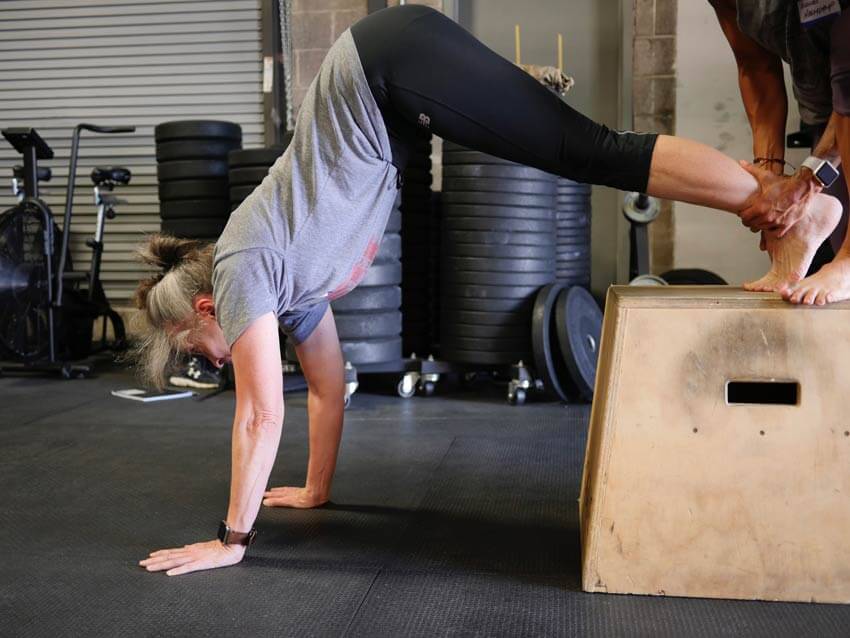Overcoming Fear of Handstands

If you've had any experience with handstand practice or play, you have likely experienced the following: you are holding a handstand facing the wall, and your arms start to shake towards the end of your set. Determined, you tell yourself to hold it just a little bit longer. Finally, the timer goes off and it is time to come down off the wall. Fatigued, you lift one trembling arm off the ground and BAM, take a less-than-graceful spill onto the floor.
When learning how to do a handstand, you have to keep safety in the forefront of your mind. Without learning how to exit safely from a handstand, your body will not feel comfortable pushing its limits to hold longer. Coach Christopher Sommer, the founder of GymnasticBodies, emphasizes that you should regularly push yourself to work hard in your training, but not if it comes at the expense of joint pain or an increased risk of injury. In order to gain comfortability going upside down and optimize your training, here are a few ways you can learn how to exit safely from a handstand.
Using the Wall: Awareness & Energy
You always need to leave yourself enough energy to come down from a handstand safely when you are facing the wall. Be aware of your surroundings (especially if there are other people to your left or right), and make sure that you save enough strength to walk your body down the wall the same way that you entered your handstand. Your core should be tight, your shoulders shrugged, and your legs locked when you enter and exit a handstand facing the wall.
If you find yourself having a hard time with these cues, don’t worry! We’ve made sure to break down these and many more in Foundation One. An example of this is the hollow body position. Done properly, hollow bodies work to strengthen your entire core. When practicing the hollow body position during the beginning of your handstand journey, all the handstand practice that you do will become much easier.
Exit 1: Off the Wall Cartwheel & Quarter Turn
To dismount, try cartwheeling out first! To do this, you’ll turn the hand on the side of your body you want to dismount out to the side, and naturally cartwheel out to the side. Allowing yourself to take more risks in finding your stack will make a HUGE difference in your freestanding line.
For the quarter turn dismount, you’ll be able to work the over-balance towards your fingers so that just as you start to tip over, you can lift one arm off the ground slightly and shift your weight so that you can safely and naturally ‘fall’ back down towards your feet with a slight turn. This may not be graceful at first, but it is an essential movement to learn in order to feel comfortable holding handstands for longer periods of time, while overcoming your fear of the floor and falling.
Exit 2: Partial Pirouette
Once you reach a certain stage in your Gymnastics Strength Training, you will need to learn how to safely exit your handstand in the middle of the floor. Again, many GST veterans have had a similar experience of falling flat on their back after over-balancing a handstand, and it can not only leave a bruise on the body but also on the ego. The good news? You can learn how to do a cartwheel and a forward roll, both of which are featured in the GB Movement Series BEFORE this happens to you!
For the purposes of this article, we will not go into all the details and exact mechanics of how to do a full gymnastics cartwheel. However, if you are practicing freestanding handstands, then it will be beneficial to learn how to do a quarter-turn or partial pirouette in order to avoid falling on your back.

Exit 3: The Forward Roll
The third way you can learn to overcome your fear of the floor is by learning the forward roll. It’s best not to learn this movement from a handstand in the beginning, but rather from a crouched position with soft mats you can roll on without hurting yourself or injuring your pride.
From a crouched or kneeling position, tuck your chin into your chest, and slightly push off the ground with your feet so that your feet can roll forward over your head. Over time, you can gradually increase the difficulty of this movement by rolling out of a headstand, a handstand with bent arms, and eventually a handstand with straight arms. Once you have overcome your fear of the floor, anything to do with a handstand will be within reach; it will now become merely a matter of practice!
Learn more fun and challenging movements for your handstand and beyond while overcoming your fear of being in unusual positions in the GymnasticBodies Movement Course.

